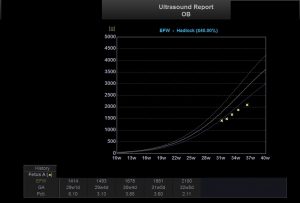At this scan specific parts of the baby will be measured to confirm that there has been satisfactory growth in line with that is expected from the due date.
Growth scans are medical scans and should last no more than 30 minutes.
In this scan we check for the following:
- Check fetal growth
- Assess placental position (low lying placenta at 20 weeks)
- Review findings from a prior ultrasound
- Monitor Anomalies with the baby (e.g. fetal renal pelvis dilatation)
What will happen on the day
When you arrive for your scan you will be asked to fill out a form about your pregnancy to date.
The sonographer will then take you through to the scanning room.
 You will be asked to lie on the table and expose your tummy. A towel will be tucked into your pants to limit spread of the gel onto your clothes.
You will be asked to lie on the table and expose your tummy. A towel will be tucked into your pants to limit spread of the gel onto your clothes.
Clear gel is applied to your tummy and the sonographer moves the probe over your tummy recording images.
Please come with a partially filled bladder which will make it easier to obtain images of your baby.
We will take specific measurements of your baby so we can monitor their growth.
Occasionally a vaginal scan is also performed to give us a better view of your baby or if you have a low-lying placenta. You will be able to watch the entire scan on our wall-mounted plasma screen monitors.
All of our sonographers are accredited with the Fetal Medicine Foundation. Each sonographer’s scanning style is different. Some like to talk you through the scan whilst others like to stay silent as that helps them concentrate on your baby. The sonographer will explain this to you before the scan. Getting detailed growth measurements is our number one priority.
Once the scan is completed the sonographer will leave the room and the results of the scan will be reviewed by our radiologist or on-site obstetrician. If you have had a previous growth scan your previous measurements will be tracked against the scan measurements on the day.
You will be given your expected due date on the day. You will receive a text message within 24 hours of your appointment with a link to access your images through our online portal. Your images will be available to view within 3 days of your appointment.
Risks
Ultrasound has been used for many years in pregnancy and is regarded as safe to you and your baby.
Sometimes we need to do a vaginal scan. If you are allergic to latex prior to the vaginal scan or you don’t know then a latex-free cover will be used on the probe.
Occasionally there is some discomfort from probe pressure on your bladder or from the vaginal probe manipulation. If this is extremely painful please let us know.
Benefits
You will be able to monitor the growth of your baby.
We are able to assess the fluid around your baby
If there is anything that we are concerned about from the scan we will inform you on the day. This is very reassuring for you and your baby.
What is an Ultrasound scan?
An ultrasound scan uses high-frequency sound waves to create images of the inside of the body and your baby. Sound waves are used instead of radiation which makes them safe.
Why have a growth scan at Women’s Imaging?
Our sonographers are trained to the highest standards to perform these specialist measurements of you and your baby. They hold Certificates in Competence from the Fetal Medicine Foundation which is recognised by the Royal Australian and New Zealand College of Obstetricians and Gynaecologists. We take detailed measurements of your baby. All of our scans are monitored by our in-house radiologist or obstetrician.
How long will it take?
The growth and wellbeing scan takes approximately 30 minutes but please give yourself lots of time. Occasionally we can’t see/scan everything because of your baby’s position.
How should I prepare for the scan?
You should arrive for your scan with a partially filled bladder. Remember to bring your referral form with you.
Important things to know
- Specific measurements of your baby are taken to assess your baby’s growth
- A Growth scan is a medical scan and should not take more than 30 minutes
- A partially filled bladder is useful for this scan